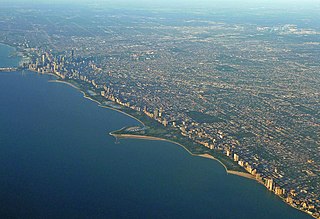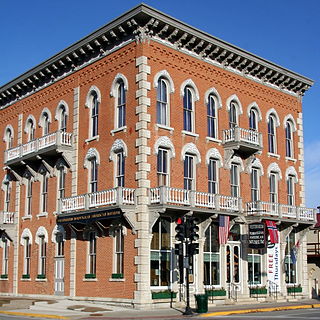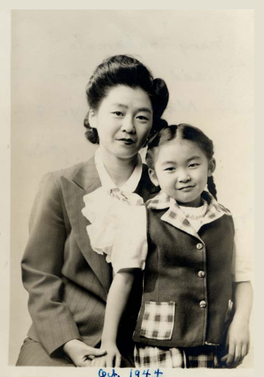
Lincoln Park is a 1,208-acre (489-hectare) park along Lake Michigan on the North Side of Chicago, Illinois. Named after US President Abraham Lincoln, it is the city's largest public park and stretches for seven miles (11 km) from Grand Avenue, on the south, to near Ardmore Avenue on the north, just north of the DuSable Lake Shore Drive terminus at Hollywood Avenue. Two museums and a zoo are located in the oldest part of the park between North Avenue and Diversey Parkway in the eponymous neighborhood. Further to the north, the park is characterized by parkland, beaches, recreational areas, nature reserves, and harbors. To the south, there is a more narrow strip of beaches east of Lake Shore Drive, almost to downtown. With 20 million visitors per year, Lincoln Park is the second-most-visited city park in the United States, behind Manhattan's Central Park.

The Museum of Science (MoS) is a nature and science museum and indoor zoological establishment located in Science Park, a plot of land in Boston and Cambridge, Massachusetts, spanning the Charles River. Along with over 700 interactive exhibits, the museum features a number of live and interactive presentations throughout the building each day, along with scheduled film showings at the Charles Hayden Planetarium and the Mugar Omni Theater.

The Science Museum of Minnesota is a museum in Saint Paul, Minnesota, focused on topics in technology, natural history, physical science, and mathematics education. Founded in 1907, the 501(c)(3) nonprofit institution has 385 employees and is supported by volunteers.

Oglebay Park is a self-supporting public municipal park, the only one of its kind, located on the outskirts of Wheeling, West Virginia, on 1,650 acres (670 ha). In 1926, Earl W. Oglebay deeded his estate, Waddington Farms, to the city of Wheeling for the express purpose of public recreation. The park has been open to the public since 1928 when its governing body, the Wheeling Park Commission, began operations.

Vesterheim Norwegian-American Museum in Decorah, Iowa is the National Norwegian-American Museum and Folk Art School, with over 33,000 artifacts, 12 historic buildings, and a library and archives. This treasure showcases one of the most extensive collection of Norwegian-American artifacts in the world and highlights the best in historic and contemporary Norwegian folk and fine arts. Some of its buildings are on the National Register of Historic Places.

The Children's Museum of Indianapolis is the world's largest children's museum. It is located at 3000 North Meridian Street, Indianapolis, Indiana in the United Northwest Area neighborhood of the city. The museum is accredited by the American Alliance of Museums. It is 472,900 square feet (43,933.85 m2) with five floors of exhibit halls, and receives more than one million visitors annually. Its collection of over 130,000 artifacts and exhibit items is divided into two domains: Arts & Humanities and the Natural Sciences. Among the exhibits are simulated Cretaceous and Jurassic dinosaur habitats, a carousel, a steam locomotive, and the glass sculpture Fireworks of Glass Tower and Ceiling. The museum's focus is family learning; most exhibits are designed to be interactive.
The Museum of Life and Science—previously known as the North Carolina Museum of Life and Science and the NC Children's Museum—is an 84-acre (340,000 m2) science museum located in Durham, North Carolina, United States.

The Museum of Appalachia, located in Norris, Tennessee, 20 miles (32 km) north of Knoxville, is a living history museum that interprets the pioneer and early 20th-century period of the Southern Appalachian region of the United States. Recently named an Affiliate of the Smithsonian Institution, the museum is a collection of more than 30 historic buildings rescued from neglect and decay and gathered onto 63 acres (25 ha) of picturesque pastures and fields. The museum also preserves and displays thousands of authentic relics, maintains one of the nation's largest folk art collections, and hosts performances of traditional Appalachian music and annual demonstrations by hundreds of regional craftsmen.
The Forest Preserve District of DuPage County is a governmental agency headquartered in Wheaton, Illinois, United States. Its mission is to acquire and hold lands containing forests, prairies, wetlands, and associated plant communities or lands capable of being restored to such natural conditions for the purpose of protecting and preserving the flora, fauna and scenic beauty for the education, pleasure and recreation of the citizens of DuPage County.

The Elgin Public Museum of Natural History and Anthropology is a natural history museum located in Elgin, Illinois. The museum, now over a hundred years old, is located within the 108-acre Lords Park.

The Phillip and Patricia Frost Museum of Science, formerly known as the Miami Science Museum or Miami Science Museum and Space Transit Planetarium, is a science museum, planetarium, and aquarium located in Miami, Florida, United States. The museum originally opened its Coconut Grove location across from Vizcaya Museum and Gardens in 1960. It relocated to Maurice A. Ferré Park in the downtown area adjacent to the Perez Art Museum Miami in 2017 after the closing of the Coconut Grove location in 2015.

The Pacific Grove Museum of Natural History is a museum of natural history located near the Monterey Bay Aquarium in Pacific Grove, California, United States. The museum is a living field guide of the California Central Coast showcasing local native plants, animals, geology, and cultural histories.

The George Washington Carver Museum is a museum located in Tuskegee, Alabama, United States. It is a part of the Tuskegee Institute National Historic Site. The museum, located on the campus of Tuskegee University, is managed by the US National Park Service, with self-guided tours.
The Autrey Mill Nature Preserve & Heritage Center is located in Johns Creek, Georgia, United States.
The Schenectady County Historical Society, located in Schenectady, New York, was established on July 14, 1905, under the Membership Corporation Laws of the State of New York. The Society is an independent not-for-profit corporation, not a unit of government. Today, the Schenectady County Historical Society brings to life the region's history through exhibits, talks, workshops, concerts, programs and community events at their three sites: Mabee Farm Historic Site, the Grems-Doolittle Library and the Schenectady History Museum, and the historic Brouwer House Creative.
The Raupp Memorial Museum is an organization that chronicles the social history of Buffalo Grove, Illinois. It is part of the Buffalo Grove Park District and an award-winning member of the Illinois Association of Museums.

Mary Tsuruko Dakusaku Tsukamoto was a Japanese American educator, cultural historian, and civil rights activist. She had taught in the Elk Grove Unified School District in Sacramento, California, for 26 years, and was described as having a passion to teach children how to learn from experience. The daughter of Japanese parents, she was relocated to an internment camp at Jerome, Arkansas, after the United States entered World War II. She developed a program about the internment period that is part of the California state curriculum for fifth grade history and a California Museum of History tour exhibit. She worked for Japanese American civil liberties, and played a pivotal role in the grassroots effort that led to the Civil Liberties Act of 1988. She also worked with the Smithsonian Institution in Washington DC, where she developed an exhibit on internment for the Constitution's bicentennial. In March 2006, she was posthumously recognized as a National Women's History Month honoree.

The Stamford Museum & Nature Center, located in Stamford, Connecticut, is an art, history, nature, and agricultural sciences museum. The property covers 118 acres beginning about half a mile north of the Merritt Parkway. It was originally a private estate.

The Page Farm & Home Museum is a museum on the campus of the University of Maine in Orono, Maine. Its mission is "to collect, document, preserve, interpret and disseminate knowledge of Maine history relating to farms and farming communities between 1865 and 1940, providing an educational and cultural experience for the public and a resource for researchers of this period." The University of Maine was founded in 1865 as the "Maine College of Agriculture and the Mechanic Arts". The centerpiece of the museum is the Maine Experiment Station Barn, a 19th-century barn, listed on the National Register of Historic Places, that is the last standing agricultural building on the campus.

The Museum of Idaho (MOI) is a history and science museum in downtown Idaho Falls, Idaho. The museum features exhibits, collections, and programs focused on the social and environmental history of Idaho and the Intermountain West, as well as prominent traveling exhibits on a variety of subjects. Its tagline is “bringing the world to Idaho, and Idaho to the world”.

















